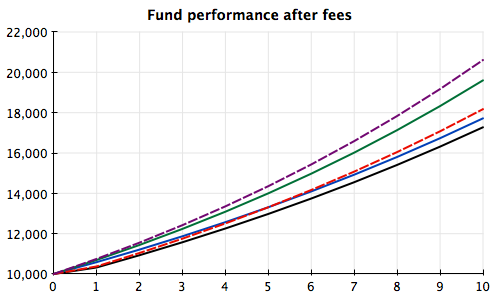Most investors understand that the fees they pay to fund managers have an impact on their investment returns. But it’s easy to overlook quite how large that impact can be. It’s also easy to focus on the wrong fees – putting a lot of effort into reducing one, when it’s the other that matters more.
So exactly how much do fees matter and what should you do to cut costs? Let’s take a look at a real example.
Before we begin, let’s recap what fees we’re looking at. There are two different sets of fees that fund management firms normally charge. One is the entry fee or initial charge, a one-off fee levied when your investment goes into the fund. The other is the annual management charge, which is levied on a recurring basis.
There are some other possible fees to keep in mind. For example, an exit fee might be charged when you withdraw your money or a performance fee levied when returns pass a certain hurdle. But these are less common and so we’ll leave them out for simplicity.
We’re going to assume that someone invests £10,000 in a fund for 10 years, earning an annual return of 7.5% per year before fees. To keep things straightforward, this is assumed to be the same return as the overall market – ie the fund neither outperforms or underperforms.
The entry fee is 2.5%, the annual management charge is 1.5% and there is an equivalent tracker fund available with an annual total expense ratio of 0.5%. These numbers are roughly typical for UK funds at present.
The chart below shows the outcome. The dotted purple line is the market return assuming no costs and fees – it’s the ideal that you’ll never reach. The bottom black line includes the 2.5% entry fee and 1.5% annual charge and is the worst case scenario.
The blue line removes the entry fee but keeps the 1.5% annual charge, while the green line cuts the management fee to the tracker level of 0.5%. The dotted red line I’ll explain in a moment.

You can see that fees make a big difference. The fund with the highest fees returns £3,334 less than the market and £2,326 less than the low-cost tracker. That’s a pretty substantial loss and shows why it’s worth paying attention to fees.
Perhaps more significantly given the way that many investors look at fees, compare the effect of cutting the entry fee with cutting the annual management charge. Many people tend to focus more on the former, because it’s a larger number.
But if you compare the black line and the blue line, you can see the difference between charging the 2.5% entry fee or not doing so amounted to £443 over the ten years. Not trivial, but not vast.
Now compare the difference between the blue line and the green line – equivalent to cutting the annual fee from 1.5% to 0.5%. The difference here is more than four times as great, at £1,883.
And because the annual management charge compounds every year, the effect of the higher fee grows larger the longer you hold the investment. A one percentage point difference in fees is worth 1% of the final fund after one year, but 10% after 10 years and 22% after 20 years.
So while you should certainly aim to reduce the entry fee you pay – ideally to nothing – don’t forget about the annual fee. It has a bigger effect over time and in fact paying a little more up front could actually be worth it if it gets you a lower annual fee.
And that’s where the dotted red line comes in. In this example, the investor makes an up front flat fee payment of £250 (chosen to be 2.5% of the initial investment again, just to make the numbers match up) and in return gets 0.5 percentage points from the annual fee rebated to him (this being roughly the best rebate an investor will get on UK funds at present).
As you can see, this investor is £454 better off than the investor who paid no initial charge, but the full 1.5% annual fee. They are £897 better off than the investor who paid the full initial charge and annual management charge.
This represents a situation where the investor either goes through a fund supermarket and discount broker or works with an independent financial adviser (IFA) on a fee basis rather than the more common commission basis (ie the IFA charges an hourly fee, but does not get ongoing trail commision from the fund).
The choice of £250 is purely hypothetical. In fact, you can buy funds for far less than £250 up front through the best fund supermarkets/discount broker combination in the UK – for Cavendish Online or Alliance Trust Savings i.nvest, it’s more like £25. And obviously, the IFA’s effective fee per fund will depend on how much work they do for you spread over how many investments and other issues.
The wider point is that by using the best fee strategy, you can make significant savings on your investments. So shop around the fund supermarkets, look for discounts on both the entry and annual fee and crunch the numbers to make sure you get the best deal.
For more on UK fund supermarkets – including the three best providers – see this article.